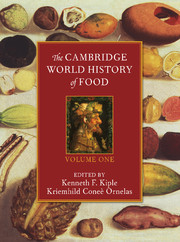Book contents
- Frontmatter
- Introduction
- Part I Determining What Our Ancestors Ate
- Part II Staple Foods: Domesticated Plants and Animals
- II.A Grains
- II.A.1 Amaranth
- II.A.2 Barley
- II.A.3 Buckwheat
- II.A.4 Maize
- II.A.5 Millets
- II.A.6 Oat
- II.A.7 Rice
- II.A.8 Rye
- II.A.9 Sorghum
- II.A.10 Wheat
- II.B Roots, Tubers, and Other Starchy Staples
- II.C Important Vegetable Supplements
- II.D Staple Nuts
- II.E Animal, Marine, and Vegetable Oils
- II.F Trading in Tastes
- II.G Important Foods from Animal Sources
- Part III Dietary Liquids
- Part IV The Nutrients – Deficiencies, Surfeits, and Food-Related Disorders
- References
II.A.1 - Amaranth
from II.A - Grains
Published online by Cambridge University Press: 28 March 2008
- Frontmatter
- Introduction
- Part I Determining What Our Ancestors Ate
- Part II Staple Foods: Domesticated Plants and Animals
- II.A Grains
- II.A.1 Amaranth
- II.A.2 Barley
- II.A.3 Buckwheat
- II.A.4 Maize
- II.A.5 Millets
- II.A.6 Oat
- II.A.7 Rice
- II.A.8 Rye
- II.A.9 Sorghum
- II.A.10 Wheat
- II.B Roots, Tubers, and Other Starchy Staples
- II.C Important Vegetable Supplements
- II.D Staple Nuts
- II.E Animal, Marine, and Vegetable Oils
- II.F Trading in Tastes
- II.G Important Foods from Animal Sources
- Part III Dietary Liquids
- Part IV The Nutrients – Deficiencies, Surfeits, and Food-Related Disorders
- References
Summary
A robust annual herb with seeds as small as mustard seeds, amaranth belongs to the genus Amaranthus of the family Amaranthaceae, with 50 to 60 species scattered throughout the world in wild and domesticated forms. Most are weeds, such as pigweed (A. retroflexus), which commonly invades gardens in the United States, whereas others are raised as ornamentals. The genus derives its name from the Greek meaning “unfading,” “immortal,” or “not withering” because the flowers remain the same after they are dried. Poets have favored the amaranth, therefore, as a symbol of immortality (Sauer 1976; Berberich 1980; Tucker 1986; Amaranthus 1991).
It is as a food, however, that amaranth was and is most important to human populations, either for its leaves or seeds. Two species of amaranth, A. tricolor and A. dubius, are popular among Chinese-Americans for soup and salad greens. But the most versatile and nutritious are the grain amaranths, because the genus Amaranthus, although a non-grass, is capable of producing great amounts of edible grain (Cramer 1987).Three species of amaranth that were domesticated in the Americas and are commonly utilized as grain are A. hypochondriacus, known as “prince’s feather” in England, from northwestern and central Mexico; A. cruentus of southern Mexico and Central America, whose greens are widely utilized in Africa; and A. caudatus of the Andes, known as “love-lies-bleeding” in the United States (Sauer 1976; Cole 1979).The first two species are now cultivated in the United States as seed grains, but A. caudatus does not do as well in the United States as in the Andes (Tucker 1986).
- Type
- Chapter
- Information
- The Cambridge World History of Food , pp. 75 - 81Publisher: Cambridge University PressPrint publication year: 2000

